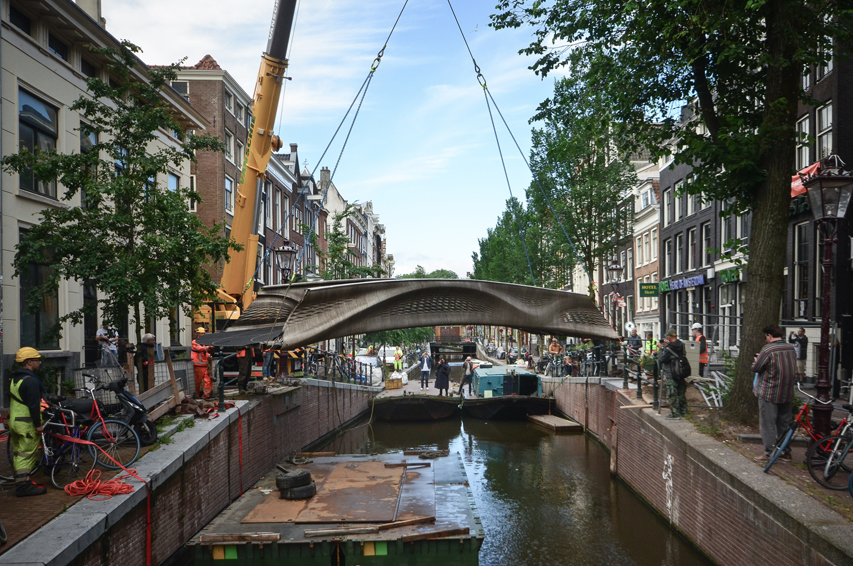3D printed bridge gathers data in Amsterdam
- August 2, 2021
- Steve Rogerson
The world’s first 3D-printed steel footbridge has been unveiled by a robot in Amsterdam. The bridge is living laboratory with a network of installed sensors to monitor pedestrian traffic.

The living laboratory was co-developed by Imperial College London and was over four years in the making in a project led by Dutch company MX3D.
Using the installed sensors, Imperial College London researchers will measure, monitor and analyse the performance of the 12-metre-long structure as it handles pedestrian traffic.
The data collected will let researchers and engineers measure the bridge’s health in real time, monitor how it changes over its lifespan and understand how the public interacts with 3D-printed infrastructure.
The data from the sensors will be put into a digital twin of the bridge – a computerised version that will imitate the physical bridge with growing accuracy in real time as sensor data come in. The performance and behaviour of the physical bridge will be tested against the twin, which will help answer questions about the long-term behaviour of 3D-printed steel, as well as its use in real-world settings and in future novel construction projects.
To get from the conceptual stage to the installed footbridge, the Steel Structures group at Imperial conducted the underpinning research and validation, including testing destructive forces on printed elements, digital twin computer simulations, non-destructive real-world testing on the footbridge and the development of a sensor network to monitor the bridge’s behaviour over its life.
“A 3D-printed metal structure large and strong enough to handle pedestrian traffic has never been constructed before,” said Leroy Gardner, a professor at Imperial’s Department of Civil & Environmental Engineering. “We have tested and simulated the structure and its components throughout the printing process and upon its completion, and it’s fantastic to see it finally open to the public.”
Imperial co-contributor Craig Buchanan, also of the Department of Civil & Environmental Engineering, added: “We look forward to continuing this work as the project transitions from underpinning research to investigating the long-term behaviour of metal printed structures. Research into this new technology for the construction industry has huge potential for the future, in terms of aesthetics and highly optimised and efficient design, with reduced material usage. It has been fascinating and we are delighted that the structure is now ready to be used.”
The testing work was led by Gardner and Buchanan, supported by a team of undergraduate and postgraduate students, PhD candidates, post-doctoral researchers and laboratory technicians. The team’s work was predominantly funded by the Alan Turing Institute, with additional funding from the Engineering & Physical Sciences Research Council, part of UK Research & Innovation.
The bridge was installed over the Oudezijds Achterburgwal canal in Amsterdam’s Red Light District and was unveiled last month by a robot.
In the absence of structural design provisions for 3D-printed steel, physical testing and computer simulation are important for ensuring the safety of 3D-printed structures. The Steel Structures group therefore undertook an ambitious research programme using small-scale destructive material and cross-section testing, computer modelling and large-scale non-destructive real-world testing on the footbridge.
“3D printing presents tremendous opportunities to the construction industry, enabling far greater freedom in terms of material properties and shapes,” said Gardner. “This freedom also brings a range of challenges and will require structural engineers to think in new ways.”
Buchanan added: “For over four years we have been working from the micrometre scale, studying the printed microstructure up to the metre scale, with load testing on the completed bridge. This challenging work has been carried out in our testing laboratories at Imperial, and during the construction process on site in Amsterdam and Enschede, the Netherlands, on the actual printed bridge.”
The Imperial researchers are part of a wider team of structural engineers, mathematicians, computer scientists and statisticians working on the Alan Turing Institute-Lloyd’s Register Foundation programme in data-centric engineering. The programme is led by Mark Girolami at the Alan Turing Institute.
“3D printing is poised to become a major technology in engineering, and we need to develop appropriate approaches for testing and monitoring to realise its full potential,” said Girolami. “When we couple 3D printing with digital twin technology, we can then accelerate the infrastructure design process, ensuring that we design optimal and efficient structures with respect to environmental impact, architectural freedom and manufacturing costs.”
The data captured from the bridge will be made available to other researchers worldwide who want to work with the Turing researchers in analysing the data. Now the bridge is unveiled, the researchers will begin collecting data in real time to monitor how it is behaving.





